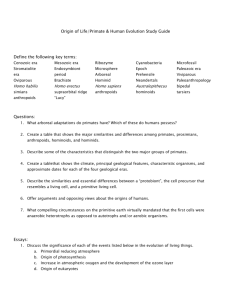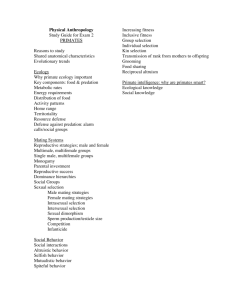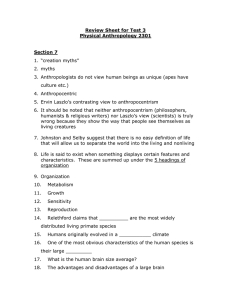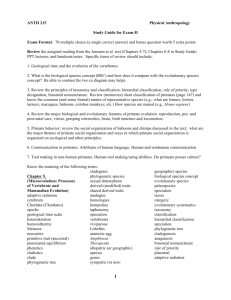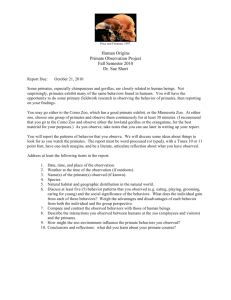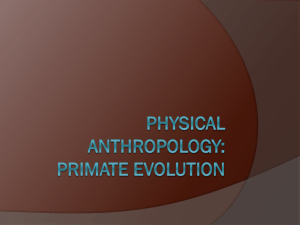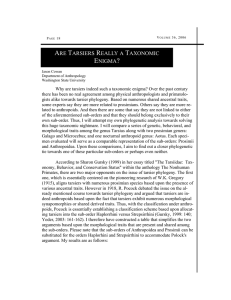Human Evolution Part I
advertisement
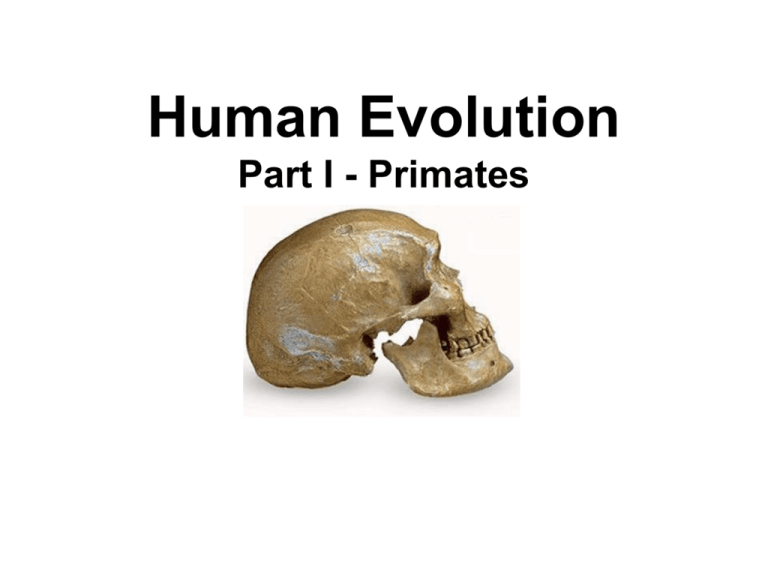
Human Evolution Part I - Primates “To understand the story of evolution, we must understand both our ancestors and our relationships to our closest living kin.” (Holt - Modern Biology – ch 17) Humans are members of the mammalian order of Primates. “As you can see, many of our behaviors and characteristics are similar to those of other primates, and some are uniquely human.” Biologists classify primates into two major groups: strepsirrhines and haplorhines. Present day strepsirrhines are small primates that include, among others, the lemurs and aye-ayes. Most strepsirrhines have large eyes and are nocturnal. aye aye found in Madagascar The remaining living primates are members of a group called haplorhines. The group consists of tarsiers and the anthropoids, the humanlike primates. Anthropoids include hominids and Old and New World monkeys. In turn hominids include apes and humans. ANTHROPOID PRIMATE: (monkeys, gibbons, orangutans, chimpanzees, gorillas & humans) Kingdom – Animalia Phylum – Chordata Subphylum – Vertebrata Class – Mammalia Order - Primate PRIMATE CHARACTERISTICS (prosimian primates – resemble early forms such as lemurs, & tarsiers.) “Primates have grasping hands, acute vision, and large brains.” “ Primate parents provide extended periods of intense care for their young, and many primate species live in complex social groups.” Primates have movable fingers and toes, and most have flattened nails rather than claws. (In some species, the feet are grasping or prehensile.) Unlike most mammals, primates have color vision. They have front-facing eyes, and overlapping fields of vision. tarsier This gives primates depth perception, a useful trait for an animal that moves by swinging or jumping from branch to branch. (An adaptation for life in the trees.) Anthropoids have well-developed a well developed collar bone, rotating shoulder joints, and partially rotating elbow joints. Anthropoids have opposable thumbs which results in increased precision of the hands. Nonhuman anthropoids have an opposable big toe. All anthropoids have a similar dental formula, or number and arrangement of teeth. Compared with other primates anthropoids have a large brain relative to their body size. Of all the Anthropoid species, the chimpanzees may be the most closely related to man. Their DNA has a high degree of similarity. “Now that scientists have decoded the chimpanzee genome. We know that 98% of our DNA is the same.” This similarly suggests That humans and chimpanzees may have shared an ancestor less than 6 million years ago.” Characteristics of Humans: Humans are bipedal—that is that they have the ability to walk on two legs. This is a uniquely human trait among mammals. Chimps can only walk in a bipedal fashion for a short period of time. The cup-shaped pelvis supports the internal organs during walking. The human spine has two curves resulting in an = “S” shape that allows for upright posture. (compared to the “C” shape in chimps) The center of gravity is located higher in the chimpanzee body than in a human body. The chimp has more weight in the upper trunk, whereas humans have more weight in the lower limbs. Pelvic shape, muscle shape and attachment, and the fact that human knees are straight rather than bent, are factors that enable humans, and not chimps, the ability of prolonged bipedal movement. The human foot, has shorter toes than apes, which are aligned with each other. This may be seen as an additional bipedal adaptation. The human jaw is more rounded than the Ushaped ape jaw. It does not protrude as an ape’s jaw. The enlargement of the human brain has resulted in a more vertical face than in apes. The human brain has extensive areas devoted to the production and understanding of speech.
